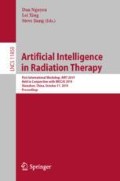Abstract
Four-dimensional computed tomography (4D-CT) has been used in radiation therapy to allow for tumor and organ motion tracking throughout the breathing cycle. It can provide valuable information on the shapes and trajectories of tumor and normal structures to guide treatment planning and improve the accuracy of tumor delineation. Respiration-induced abdominal tissue motion causes significant problems in effective irradiation of abdominal cancer patients. Accurate and fast deformable image registration (DIR) on 4D-CT could aid the treatment planning process in target definition, tumor tracking, organ-at-risk (OAR) sparing, and respiratory gating. However, traditional DIR methods such as optical flow and demons are iterative and generally slow especially for large 4D-CT datasets. In this paper, we present our preliminary results on using a fast-unsupervised generative adversarial network (GAN) to generate deformation vector fields (DVF) for 4D-CT DIR to help motion management and treatment planning in radiation therapy. The proposed network was trained in an unsupervised fashion without the need of ground truth DVF or anatomical labels. A dilated inception module (DIM) was integrated into the network to extract multi-scale motion features for robust feature learning. The network was trained and tested on 15 patients’ 4D-CT abdominal datasets using five-fold out cross validation. The experimental results demonstrated that the proposed method could attain an accurate DIR between any two 4D-CT phases within one minute.
Access this chapter
Tax calculation will be finalised at checkout
Purchases are for personal use only
References
D’Souza, W.D., et al.: The use of gated and 4D CT imaging in planning for stereotactic body radiation therapy. Med. Dosim. 32(2), 92–101 (2007)
Tai, A., Liang, Z., Erickson, B., Li, X.: Management of respiration-induced motion with 4-dimensional computed tomography (4DCT) for pancreas irradiation. Int. J. Radiat. Oncol. 86(5), 908–913 (2013)
Yang, X., et al.: Automated segmentation of the parotid gland based on atlas registration and machine learning: a longitudinal MRI study in head-and-neck radiation therapy. Int. J. Radiat. Oncol. 90(5), 1225–1233 (2014)
Haskins, G., Kruger, U., Yan, P.: Deep learning in medical image registration: a survey. ArXiv, abs/1903.02026 (2019)
Ghosal, S., Rayl, N.: Deep deformable registration: enhancing accuracy by fully convolutional neural net. Pattern Recogn. Lett. 94, 81–86 (2017)
Wu, G., Kim, M., Wang, Q., Munsell, B.C., Shen, D.: Scalable high-performance image registration framework by unsupervised deep feature representations learning. IEEE Trans. Bio-Med. Eng. 63(7), 1505–1516 (2016)
de Vos, B.D., Berendsen, F.F., Viergever, M.A., Staring, M., Išgum, I.: End-to-end unsupervised deformable image registration with a convolutional neural network. In: Cardoso, M.J., et al. (eds.) DLMIA/ML-CDS -2017. LNCS, vol. 10553, pp. 204–212. Springer, Cham (2017). https://doi.org/10.1007/978-3-319-67558-9_24
Klein, S., Staring, M., Murphy, K., Viergever, M.A., Pluim, J.P.W.: Elastix: a toolbox for intensity-based medical image registration. IEEE Trans. Med. Imaging 29(1), 196–205 (2010)
Szegedy, C., et al.: Going deeper with convolutions. In: IEEE CVPR 2015, pp. 1–9 (2015)
Wang, B., et al.: Deeply supervised 3D fully convolutional networks with group dilated convolution for automatic MRI prostate segmentation. Med. Phys. 46(4), 1707–1718 (2019)
Zhu, H.C., et al.: Dilated dense U-net for infant hippocampus subfield segmentation. Front. Neuroinform. 13, 30 (2019)
Ronneberger, O., Fischer, P., Brox, T.: U-net: convolutional networks for biomedical image segmentation. In: Navab, N., Hornegger, J., Wells, W.M., Frangi, A.F. (eds.) MICCAI 2015. LNCS, vol. 9351, pp. 234–241. Springer, Cham (2015). https://doi.org/10.1007/978-3-319-24574-4_28
Gao, F., Wu, T., Chu, X., Yoon, H., Xu, Y., Patel, B.: Deep residual inception encoder-decoder network for medical imaging synthesis. IEEE J. Biomed. Health Inform. (2019, in press)
Lei, Y., et al.: MRI-only based synthetic CT generation using dense cycle consistent generative adversarial networks. Med. Phys. 46(8), 3565–3581 (2019)
Acknowledgements
This research is supported in part by the National Cancer Institute of the National Institutes of Health under Award Number R01CA215718, and Dunwoody Golf Club Prostate Cancer Research Award, a philanthropic award provided by the Winship Cancer Institute of Emory University.
Author information
Authors and Affiliations
Corresponding author
Editor information
Editors and Affiliations
Ethics declarations
The authors declare no conflicts of interest.
Rights and permissions
Copyright information
© 2019 Springer Nature Switzerland AG
About this paper
Cite this paper
Lei, Y. et al. (2019). 4D-CT Deformable Image Registration Using an Unsupervised Deep Convolutional Neural Network. In: Nguyen, D., Xing, L., Jiang, S. (eds) Artificial Intelligence in Radiation Therapy. AIRT 2019. Lecture Notes in Computer Science(), vol 11850. Springer, Cham. https://doi.org/10.1007/978-3-030-32486-5_4
Download citation
DOI: https://doi.org/10.1007/978-3-030-32486-5_4
Published:
Publisher Name: Springer, Cham
Print ISBN: 978-3-030-32485-8
Online ISBN: 978-3-030-32486-5
eBook Packages: Computer ScienceComputer Science (R0)


